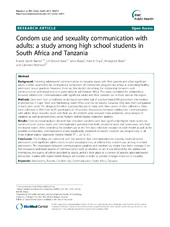| dc.description.abstract | Background: Fostering adolescents’ communication on sexuality issues with their parents and other significant adults is often assumed to be an important component of intervention programmes aimed at promoting healthy adolescent sexual practices. However, there are few studies describing the relationship between such communication and sexual practices, particularly in sub-Saharan Africa. This study examined the relationships between adolescents’ communication with significant adults and their condom use in three sites in this region. Methods: Data stem from a multi-site randomized controlled trial of a school-based HIV prevention intervention implemented in Cape Town and Mankweng, South Africa and Dar es Salaam, Tanzania. Only data from comparison schools were used. The design is therefore a prospective panel study with three waves of data collections. Data were collected in 2004 from 6,251 participants in 40 schools. Associations between adolescents’ communication with adults about sexuality issues and their use of condoms were analysed cross-sectionally using analysis of variance, as well as prospectively using multiple ordinal logistic regression analysis. Results: Cross-sectional analyses showed that consistent condom users had significantly higher mean scores on communication (across topics and communication partners) than both occasional users and never-users, who had the lowest scores. After controlling for condom use at the first data collection occasion in each model as well as for possible confounders, communication scores significantly predicted consistent condom use prospectively in all three ordinal logistic regression models (Model R² = .23 to .31). Conclusion: The findings are consistent with the assertion that communication on sexuality issues between adolescents and significant adults results in safer sexual practices, as reflected by condom use, among in-school adolescents. The associations between communication variables and condom use might have been stronger if we had measured additional aspects of communication such as whether or not it was initiated by the adolescents themselves, the quality of advice provided by adults, and if it took place in a context of positive adult-adolescent interaction. Studies with experimental designs are needed in order to provide stronger evidence of causality. | en_US |

